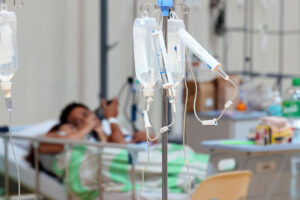SUBSIDIES PROVIDED to government-owned and -controlled corporations (GOCCs) dropped by an annual 14% in September, according to the Bureau of the Treasury (BTr).
The latest data from the Treasury showed that budgetary support to GOCCs declined by 14.33% to P18.22 billion in September from P21.26 billion in the same month a year ago.
Month on month, GOCC subsidies doubled (100.19%) from P9.1 billion in August.
State-owned firms receive monthly subsidies from the National Government (NG) to support their daily operations if their revenue is insufficient.
In September, the Philippine Health Insurance Corp. (PhilHealth) received the biggest amount of subsidies at P9.34 billion, accounting for 51.27% of the total.
This was the second time PhilHealth received subsidies this year, after the P260 million it got in June.
The National Irrigation Authority (NIA) received the second-biggest amount of government subsidies for the month at P5.5 billion, followed by the National Electrification Administration at P1.01 billion.
Several GOCCs received at least P200 million in subsidies, including the Philippine Crop Insurance Corp. (P353 million), Philippine Heart Center (P348 million), Social Housing Finance Corp. (P284 million), and the National Kidney and Transplant Institute (P223 million).
At least P100 million in subsidies were given to the Philippine National Railways (P171 million), Philippine Children’s Medical Center (P151 million), National Power Corp. (144 million), and the Philippine Coconut Authority (P112 million).
State-owned corporations that received at least P50 million include the Cultural Center of the Philippines with P80 million, Light Rail Transit Authority with P72 million, Lung Center of the Philippines with P70 million, Development Academy of the Philippines with P64 million, and the Tourism Promotions Board with P54 million.
In September, no subsidies were given to the Bangko Sentral ng Pilipinas, National Home Mortgage Finance Corp., Philippine Deposit Insurance Corp., Small Business Corp., and the National Housing Authority.
GOCCs that also received zero subsidies during the month include the National Food Authority, Bases Conversion and Development Authority, Philippine Fisheries Development Authority, Philippine Postal Corp., Power Sector Assets and Liabilities Management Corp. (PSALM), and the Tourism Infrastructure and Enterprise Zone Authority.
In the January-September period, GOCC subsidies fell by 23.25% to P105.24 billion from P137.13 billion in the same period last year.
The NIA remained the top recipient of subsidies in the nine-month period with P54.38 billion, followed by PhilHealth (P9.6 billion), and PSALM (P8 billion).
Rizal Commercial Banking Corp. Chief Economist Michael L. Ricafort said that GOCCs received less subsidies in September “amid the need to better manage/narrow the NG budget deficit through more disciplined government spending.”
As of end-September, the NG’s fiscal gap slightly narrowed by 1.35% to P970.2 billion from P983.5 billion a year ago.
“Subsidies decline for a host of reasons, likely due to: funding reallocation from subsidy to calamity response and recovery, social amelioration and protection programs; and the increased profits of GOCCs — warranting the NG to reallocate funds for other pressing matters like infrastructure spending, DRRM (disaster risk reduction and management) response, and social protection programs,” Philippine Institute for Development Studies Senior Research Fellow John Paolo R. Rivera said via Viber.
In the coming months, the government must increase its subsidies to GOCCs that are involved in education and nutrition, Mr. Ricafort said.
“GOCCs [that should receive higher subsidies] include those needed by the poorest of the poor, and those that would have the greatest impact in society such as healthcare, nutrition, even others related to education and boosting productivity,” he said in a Viber message. — Beatriz Marie D. Cruz

